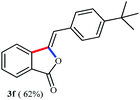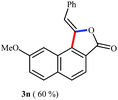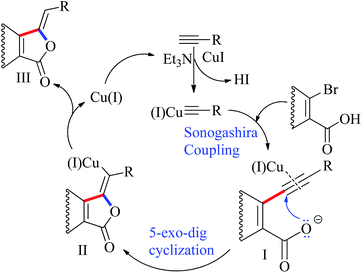Pd-free Sonogashira coupling: one pot synthesis of phthalide via domino Sonogashira coupling and 5-exo-dig cyclization†
Shubhendu Dhara,
Raju Singha,
Munmun Ghosh,
Atiur Ahmed,
Yasin Nuree,
Anuvab Das and
Jayanta K. Ray*
Department of Chemistry, Indian Institute of Technology, Kharagpur-721302, India. E-mail: jkray@chem.iitkgp.ernet.in; Fax: +91 3222282252; Tel: +91 3222283326
First published on 29th August 2014
Abstract
Phthalides have been synthesized exclusively in one pot via Pd-free Sonogashira coupling. A Cu-catalyzed domino Sonogashira coupling and 5-exo-dig cyclization between suitable substituted ortho-bromobenzoic acids and terminal alkynes afforded phthalides in good yields under mild reaction conditions.
Phthalides are the core structural subunits of many drug candidates.1 Though many phthalide derivatives are used in clinical medicine, the two most important marketed drugs are antiarthritic agent talniflumate2 and the immunosuppressant drug mycophenolate mofetil.3 Particularly C3-substituted phthalides are exemplified by the natural products cytosporone E (1),4 fuscinarin (2),5 cryphonectric acid (3)6 (Fig. 1) an important intermediate in synthesis of complex natural products.7
Therefore, owing to their pharmacological importance and synthetic utility in organic synthesis development of efficient and economic method of preparation is of considerable interest for last few decades.
A number of methods for the synthesis of 3-substituted phthalide have been developed, most of them involved the cyclization of ortho-substituted arylaldehydes8 or C3-alkylation of phthalides.9 Recently, several transition-metal mediated syntheses of phthalide such as, Ru-catalysed cross-dehydrogenative coupling10 and Ru- or Rh-catalyzed intramolecular hydroacylation11 have been reported. In literature there are few reactions involving Pd-free Sonogashira coupling for the synthesis of heterocycles and carbocycles. We envisaged that regio-selectively 3-substituted phthalides could be obtained by domino Sonogashira coupling and 5-exo-dig cyclization (Scheme 1).
Consequently, in this report we have described an interesting method for one-pot synthesis of 3-substituted phthalides exclusively starting from o-bromobenzoic acid and terminal alkyne (Scheme 2).
The precursor 2-bromobenzoic acids were prepared in moderate to good yields via Pinnick oxidation12 from the corresponding aldehydes. We started the investigation of the domino process with simple 2-bromobenzoic acid (1 mmol) and phenylacetylene (0.1 mmol) (Table 1). While screening with different Cu-salt, we identified CuI (10 mmol%) as a convenient and inexpensive catalyst that is more effective over the other. DMF gave the better yields of the product compared to other solvents. Addition of ligands (such as, 1, 10-phenanthroline) did not have marked effect on the reaction yields (Table 1, entry 6). Amine base triethylamine have prominent effect on reaction among the organic and inorganic bases. Some increment of the product yields was resulted with elevation of temperature from 60 °C to 80 °C (Table 1, entry 7). Further elevation temperature to 100 °C did not affect the yields of the reaction.
| Entry | Catalyst | Base | Solvent | Temp. (°C) | Time (h) | Yieldb (%) |
|---|---|---|---|---|---|---|
| a Reaction conditions: o-bromobenzoic acids (1 mmol), phenylacetylene (0.1 mmol), base (3.0 mmol), Cu-salt (10 mol%), solvent (3 mL).b Isolated yield.c With 1,10-phenanthroline ligand. | ||||||
| 1 | CuI | Et3N | DMF | 60 | 3 | 75 |
| 2 | CuBr | Et3N | DMF | 60 | 3 | 45 |
| 3 | CuCl | Et3N | DMF | 60 | 3 | 30 |
| 4 | Cu(OTf)2 | Et3N | DMF | 60 | 3 | 25 |
| 5 | Cu(OAc)2 | Et3N | DMF | 60 | 3 | 0 |
| 6 | CuI | Et3N | DMF | 60 | 3 | 74c |
| 7 | CuI | Et3N | DMF | 80 | 3 | 90 |
| 8 | CuI | Et3N | DMF | 80 | 5 | 65 |
| 9 | CuI | Et3N | DMA | 80 | 3 | 65 |
| 10 | CuI | Et3N | DMSO | 80 | 3 | 53 |
| 11 | CuI | NaOAc | DMF | 80 | 3 | 50 |
| 12 | CuI | Na2CO3 | DMF | 80 | 3 | 41 |
| 13 | CuI | K2CO3 | DMF | 80 | 3 | 44 |
| 14 | CuI | Et3N | DMF | 100 | 3 | 90 |
We found that prolonged reaction time did not give better conversion of phthalides. Optimal conditions for the domino reaction were finalized to be CuI (10 mol%), Et3N (3.0 mmol), DMF (3 mL), 80 °C, 3 h.
Exclusive formation of the phthalide was unambiguously confirmed by the single crystal structure analysis of the product formed with an exo-cyclic double. CCDC of the compound 3a is 1000643† and ORTEP of the compound is shown in Fig 2.
The scope and generality of the reaction was demonstrated by synthesizing a number of structurally diverse phthalide derivatives with varying substituents (Table 2). Results described in the Table 2 shows that our synthetic protocol has a wide range functional group tolerance, including amine, alkyl, halogens, methoxy and primary alcoholic OH. Influence of the electron-donating and withdrawing functional groups on both the coupling partner is quite clear from the results in Table 2. Electron withdrawing group such as F and pyridyl ring in combination with COOH in the 2-bromobenzoic acid part increase the reactivity of the C–Br bond producing good yields of phthalides (3b, 3l). In contrast, electron-donating group methyl, methoxy, tBu in both acids and alkyne part decrease the reactivity of alkyne moiety as well as C–Br bond resulting lower yields of phthalides (3c, 3d, 3f). A steric factor may be operating in the o-chloro substituent and the bulky aryl group in the alkyne part which afforded quite lower amount the phthalide formation (3g, 3i, 3j)‡.
We propose that the reaction proceeds via domino reaction of Cu-mediated Sonogashira coupling and intramolecular 5-exo-dig cyclization (Scheme 3). Firstly, CuI in presence of Et3N base formed Cu-acetylide which undergoes a Sonogashira type coupling with the C–Br bond to afford the o-alkynylcarboxylate (I). Intramolecular attack of the carboxylate on the Cu(I) co-ordinated electrophilic o-alkyne moiety in a 5-exo-dig fashion to give the intermediate II. The intermediate II finally produced our desired compound III and Cu(I) which enters into the catalytic cycle.
Conclusions
In conclusion, we have developed a very short and efficient methodology for the regio-selective synthesis of 3-substituted phthalide using very cheap starting materials and under mild reaction conditions. Our methodology is a very convenient one to be applied in the total synthesis of complex molecules of prevalent pharmacological values.Notes and references
- (a) K. Knepper, R. E. Ziegert and S. T. Bräse, Tetrahedron, 2004, 60, 8591–8603 CrossRef CAS PubMed and references therein; ; (b) T. V. Hung, B. A. Mooney, R. H. Prager and J. M. Tippett, Aust. J. Chem., 1981, 34, 383–395 CrossRef CAS.
- (a) Phthalidyl-2-(3′-trifluoromethylanilino)-pyridine-3-carboxylate and process for its preparation, Laboratorios Bago Sociedad Anonima, Br. Pat. GB 1553171, 1979, Chem. Abstr. 1980, 93, 8024; (b) H. Torriani, Drugs Future, 1979, 4, 448–450 Search PubMed; (c) Ann. Drug Data Rep., 1982, vol. 4, pp. 195–196 Search PubMed.
- (a) P. H. Nelson, C.-L. L. Gu, A. C. Allison, E. M. Eugui and W. A. Lee, U.S. Pat., 4,753,935, 1988, Chem. Abstr. 1988, 109, 149226; (b) C. Robinson and J. Castaner, Drugs Future, 1995, 20, 356–361 Search PubMed.
- S. F. Brady, M. M. Wagenaar, M. P. Singh, J. E. Janso and J. Clardy, Org. Lett., 2000, 2, 4043–4046 CrossRef CAS PubMed.
- K. Yoganathan, C. Rossant, S. Ng, Y. Huang, M. S. Butler and A. D. Buss, J. Nat. Prod., 2003, 66, 1116–1117 CrossRef CAS PubMed.
- A. Arnone, G. Assante, G. Nasini, S. Strada and A. Vercesi, J. Nat. Prod., 2002, 65, 48–50 CrossRef CAS PubMed.
- (a) L. Patil, H. B. Borate, D. E. Ponde and V. H. Deshpande, Tetrahedron, 2002, 58, 6615–6620 CrossRef; (b) D. Mal and P. Pahari, Chem. Rev., 2007, 107, 1893–1918 CrossRef PubMed; (c) R. Karmakar, P. Pahari and D. Mal, Chem. Rev., 2014, 114, 6213–6284 CrossRef CAS PubMed.
- (a) J. H. Park, S. V. Bhilare and S. W. Youn, Org. Lett., 2011, 13, 2228–2231 CrossRef CAS PubMed; (b) J. Mangas-Sanchez, E. Busto, V. Gotor-Fernandez and V. Gotor, Org. Lett., 2012, 14, 1444–1447 CrossRef CAS PubMed; (c) D. C. Gerbino, D. Augner, N. Slavov and H.-G. Schmalz, Org. Lett., 2012, 14, 2338–2341 CrossRef CAS PubMed.
- M. Singh and N. P. Argade, J. Org. Chem., 2010, 75, 3121–3124 CrossRef CAS PubMed.
- L. Ackermann and J. Pospech, Org. Lett., 2011, 13, 4153–4155 CrossRef CAS PubMed.
- (a) D. Phan, B. Kim and V. M. Dong, J. Am. Chem. Soc., 2009, 131, 15608–15609 CrossRef CAS PubMed; (b) S. Omura, T. Fukuyama, Y. Murakami, H. Okamoto and I. Ryu, Chem. Commun., 2009, 6741–6743 RSC . See also; ; (c) M. C. Willis, Angew. Chem., Int. Ed., 2010, 49, 6026–6027 CrossRef CAS PubMed.
- B. S. Bal, W. E. Childers Jr and H. W. Pinnick, Tetrahedron, 1981, 37, 2091 CrossRef CAS.
Footnotes |
| † Electronic supplementary information (ESI) available. CCDC 1000643. For ESI and crystallographic data in CIF or other electronic format see DOI: 10.1039/c4ra07639g |
‡ General procedure of the preparation of 3-substituted phthalides: o-bromobenzoic acids (1 mmol), terminal alkyne (0.1 mmol), Et3N (3.0 mmol), CuI (10 mol%) and 3 mL of DMF were taken in a 25 mL round bottomed flask in argon atmosphere. The mixture was heated to 80 °C temperature for 3 h. The completion of the reaction was monitored by TLC checking. After completion of the reaction mixture was cooled to room temperature and diluted with water. It was then extracted with ethyl acetate (3 × 50 mL). Combined organic layer was washed with brine and evaporated to dryness under reduced pressure. The desired phthalide was isolated by usual column chromatography with a mixture of ethyl acetate and petroleum ether (1![[thin space (1/6-em)]](https://www.rsc.org/images/entities/char_2009.gif) : :![[thin space (1/6-em)]](https://www.rsc.org/images/entities/char_2009.gif) 20) as eluent. Spectral data of the representative compound 3-benzylideneisobenzofuran-1(3H)-one (3a): white solid; mp: 84–86 °C; yield: 90%; 1H NMR (200 MHz, CDCl3): 6.40 (1H, s), 7.29–7.44 (3H, m), 7.48–7.56 (1H, m), 7.66–7.76 (2H, m), 7.82–7.92 (3H, m); 13C NMR (50 MHz, CDCl3): 107.2, 120.0, 123.4, 125.6, 128.5, 128.9 (2C), 129.8, 130.2 (2C), 133.2, 134.6, 140.7, 144.7, 167.2; elemental analysis: C: 81.07%; H: 4.54%; found: C: 81.00%; H: 4.49%; HRMS of C15H11O2+ [M + H+]: 223.0754; observed: 223.0750. 20) as eluent. Spectral data of the representative compound 3-benzylideneisobenzofuran-1(3H)-one (3a): white solid; mp: 84–86 °C; yield: 90%; 1H NMR (200 MHz, CDCl3): 6.40 (1H, s), 7.29–7.44 (3H, m), 7.48–7.56 (1H, m), 7.66–7.76 (2H, m), 7.82–7.92 (3H, m); 13C NMR (50 MHz, CDCl3): 107.2, 120.0, 123.4, 125.6, 128.5, 128.9 (2C), 129.8, 130.2 (2C), 133.2, 134.6, 140.7, 144.7, 167.2; elemental analysis: C: 81.07%; H: 4.54%; found: C: 81.00%; H: 4.49%; HRMS of C15H11O2+ [M + H+]: 223.0754; observed: 223.0750. |
| This journal is © The Royal Society of Chemistry 2014 |

















































